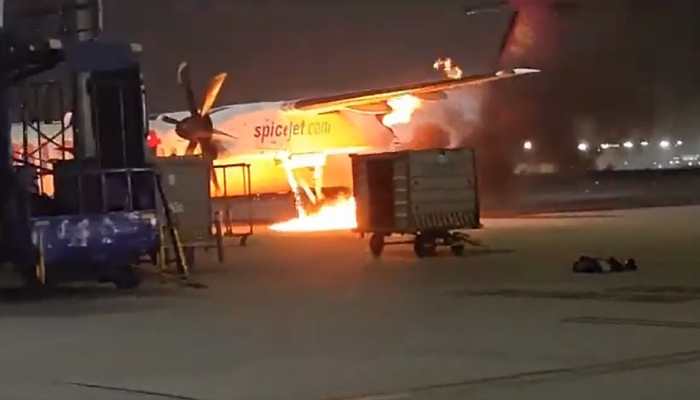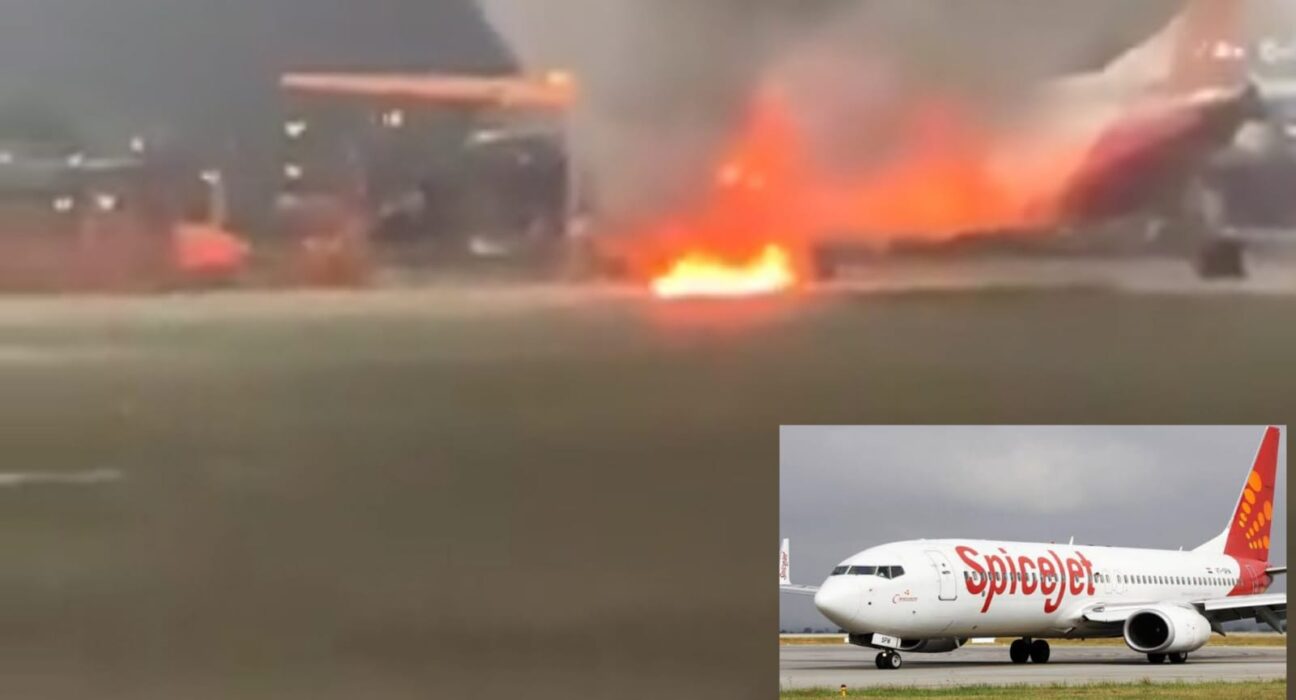SpiceJet aircraft catches fire at Delhi airport during engine maintenance

SpiceJet aircraft catches fire at Delhi airport during engine maintenance
On July 25, a SpiceJet Q400 aircraft caught fire at Delhi airport while undergoing engine maintenance works. The incident occurred during engine ground run at idle power at the bay. The Aircraft Maintenance Engineer (AME) noticed a fire warning on the #1 engine and immediately activated the aircraft fire extinguisher bottle. As a precautionary measure, the fire brigade was called to the scene.
Thankfully, both the aircraft and maintenance personnel are reported to be safe. SpiceJet has assured that the situation was promptly handled, and the necessary safety measures were taken to prevent any further escalation of the incident. Investigations into the cause of the fire and further assessments of the aircraft’s condition will likely be conducted to ensure its safety and airworthiness for future operations.
In October of the previous year, an IndiGo flight faced a tense situation at the Delhi airport when one of its engines caught fire while the aircraft was taxiing. The incident prompted the pilots to declare an emergency, ensuring swift action to address the situation and ensure the safety of the passengers and crew.
The flight in question was an A320 aircraft bound for Bengaluru, with a total of 184 people on board. As the aircraft was preparing for takeoff and taxiing on the runway, a sudden fire erupted from one of its engines. The sight of flames and sparks flying from the engine caused immediate concern among the passengers and crew members.
In response to the emergency situation, the pilots promptly initiated the aircraft’s emergency procedures, which included declaring an emergency to the air traffic control tower. By declaring an emergency, the pilots communicated to the authorities that the flight required immediate priority and assistance to address the engine fire situation.
)
Upon receiving the emergency alert, the air traffic control tower swung into action, coordinating with the flight crew and emergency response teams on the ground. The priority was to ensure the safe return of the aircraft to the nearest available bay, where the passengers and crew could disembark and be evacuated from the aircraft in an orderly manner.
Passengers on board the flight described moments of anxiety and tension as they became aware of the engine fire. However, they also commended the calm and professional demeanor of the cabin crew, who efficiently communicated emergency procedures and reassured the passengers throughout the incident.
Videos of the aircraft on social media captured the alarming sight of one of the engines engulfed in flames while the aircraft was still taxiing on the runway. The incident attracted widespread attention and concern, with many hoping for a safe resolution to the emergency.

The flight crew, guided by their training and expertise, successfully navigated the aircraft back to the bay with careful control and coordination. Once safely parked, the evacuation process commenced, and passengers and crew quickly exited the aircraft via the emergency slides.
Emergency response teams were stationed nearby and sprang into action, providing immediate assistance to the passengers and crew during the evacuation process. The efficient response from the ground staff and emergency personnel contributed to the successful and safe evacuation of all individuals on board.
After the successful evacuation, the emergency services proceeded to extinguish the fire and assess the aircraft for any further damage. The incident was thoroughly investigated by the relevant aviation authorities to determine the cause of the engine fire and to prevent such situations in the future.
IndiGo, like all airlines, places a strong emphasis on safety and adheres to strict maintenance protocols and procedures to ensure the airworthiness of its fleet. Incidents like this are treated with utmost seriousness, and the airline promptly cooperates with regulatory authorities during investigations to identify any contributing factors and implement necessary improvements to prevent similar occurrences.
In a statement issued by IndiGo, it was revealed that the aircraft, which was operating as flight 6E2131 from Delhi to Bengaluru, encountered an engine stall during the take-off roll. As a result of the engine stall, the take-off was promptly aborted, and the aircraft safely returned to the designated bay at the airport.
To ensure the comfort and convenience of all passengers on board, IndiGo promptly made arrangements to accommodate them on an alternate aircraft. The airline prioritized the safety and well-being of its passengers and crew, and the decision to transfer them to another aircraft was taken to ensure a smooth and uninterrupted travel experience.
The incident was taken seriously by IndiGo, and the relevant authorities were informed to initiate an investigation into the cause of the engine stall. Identifying the factors that contributed to the engine stall is essential for enhancing safety measures and preventing similar occurrences in the future.
IndiGo, as a reputable airline, adheres to strict safety protocols and maintenance standards to ensure the airworthiness of its fleet. When unexpected incidents like engine stalls occur, the airline’s well-trained flight crew and ground staff promptly respond to minimize any potential risks and prioritize the safety of passengers and crew members.
The incident highlights the airline’s commitment to safety and its emphasis on swiftly addressing any unexpected challenges during flights. IndiGo is known for its dedication to maintaining a high standard of safety and service, and incidents like this are thoroughly investigated to uphold the airline’s reputation for safety and reliability.In June of the previous year, an incident involving a SpiceJet aircraft bound for Delhi made headlines when it caught fire shortly after take-off from the Patna airport.
The flight, carrying 185 passengers, encountered a critical situation as the fire broke out, prompting the flight crew to initiate emergency procedures. With utmost professionalism and quick thinking, the pilot managed to perform an emergency landing just minutes after take-off, ensuring the safety of all passengers and crew members.
This particular incident was not the only one of its kind involving SpiceJet aircraft. Prior to the Patna incident, there was another incident a little over a month earlier, where a SpiceJet plane was forced to turn back within minutes of taking off. On May 3, a SpiceJet Boeing 737-8 Max aircraft departed from Chennai but had to return to the airport shortly after take-off, this time en route to West Bengal’s Durgapur. While the specific details of the May 3 incident were not elaborated upon, the fact that it required a return to the departure airport underscored the seriousness with which such situations are treated by the airline.

In both instances, SpiceJet demonstrated its commitment to safety and the well-being of its passengers and crew. The flight crews efficiently implemented emergency protocols, and the airline promptly cooperated with the relevant authorities to conduct thorough investigations into the causes of these incidents. Understanding the factors behind such occurrences is essential for ensuring that appropriate safety measures are put in place and to prevent similar situations from happening in the future.
SpiceJet, like any reputable airline, places a significant emphasis on safety and adheres to strict maintenance and operational protocols. Incidents like these are treated with the utmost seriousness and are learning opportunities for the airline to further enhance its safety practices and procedures.
While any incident involving an aircraft is cause for concern, it is crucial to acknowledge that aviation remains one of the safest modes of transportation due to the stringent safety measures and continuous improvement in operational standards adopted by airlines and regulatory bodies. SpiceJet, as a responsible carrier, remains committed to maintaining the highest standards of safety and service for its passengers and crew.
In the incident that took place at Patna airport, a SpiceJet aircraft took off shortly after noon, but within a short period, reports started pouring in about the aircraft catching fire. The local administration received numerous frantic calls from concerned individuals, particularly residents of the nearby Phulwari Sharif locality, who witnessed flames emanating from the plane. The situation prompted immediate action, with authorities swiftly responding to the emergency.
District Magistrate Chandrashekhar Singh addressed the media at the airport, providing reassurance that all 185 occupants of the aircraft were safe. This confirmation came as a relief to passengers’ families and friends, who had understandably been concerned about the well-being of their loved ones on board.
While the exact cause of the fire was not immediately known, it was evident that the incident was a critical one, and the safety of passengers and crew was of paramount importance.
The airline’s flight crew promptly executed their emergency procedures, ensuring that the situation was handled with precision and expertise. Their ability to respond effectively in such a challenging situation is a testament to the rigorous training and commitment to safety maintained by airlines like SpiceJet.
As the local administration and relevant authorities swung into action, the airport’s emergency response mechanisms were activated to address the incident swiftly and efficiently. Emergency services and fire brigades rushed to the scene to ensure that the situation was under control and that any potential risks were mitigated.
SpiceJet, as an airline, holds safety as its foremost priority, and incidents like this underscore the importance of rigorous safety measures and continuous improvement in operational practices. While such occurrences are rare, airlines are well-prepared to handle emergencies of this nature, and their flight crews are equipped to manage challenging situations with professionalism and expertise.
In the aftermath of the incident, investigations were initiated to determine the root cause of the fire. Such inquiries are standard procedure in any aviation incident and are crucial for understanding the factors that led to the occurrence. Lessons learned from these investigations can lead to further enhancements in safety protocols and procedures to prevent similar incidents in the future.
The fact that all occupants on board the aircraft, including passengers and crew, were unharmed is a testament to the effectiveness of the airline’s safety measures and the quick response of the flight crew. The incident serves as a reminder of the resilience of the aviation industry and the commitment of airlines to maintaining the highest standards of safety.
Overall, the SpiceJet aircraft incident at Patna airport was managed effectively, and all 185 occupants’ safety was ensured. The prompt response of the local administration, airport authorities, and emergency services contributed to a successful outcome.
The airline’s commitment to safety and the well-being of its passengers and crew was evident in the way the situation was handled with professionalism and efficiency. As investigations continue, the aviation industry will strive to incorporate any necessary improvements to further enhance safety measures and maintain its standing as one of the safest modes of transportation.



